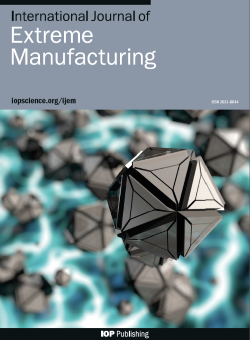探索激光诱导水热反应快速合成电催化电极的新途径
IF 21.3
1区 工程技术
Q1 ENGINEERING, MANUFACTURING
引用次数: 0
摘要
摘要电化学从水中制氢需要开发出活性、稳定、低成本的水分解电催化剂。与传统的粉末电极制备相比,为了提高电催化剂的大规模应用的催化活性和长期稳定性,合成无粘结剂的电催化集成电极是非常理想的。在此,我们展示了激光诱导水热(LIHR)技术在泡沫镍上生长NiMoO4纳米片,然后在H2/Ar混合气体下煅烧制备集成电极ie - nimo4 - lr。该电极具有优异的析氢反应性能,需要59、116和143 mV的过电位才能达到100、500和1000 mA cm-2的电流密度。在100和500 mA cm-2的电流密度下进行350小时时电位测定试验,过电位基本保持不变。此外,采用相同的LIHR方法制备了Ni泡沫上生长的nife层状双氢氧化物,并结合IE-NiMo-IR实现了水裂解。这种组合在工业电流密度下表现出优异的耐久性。对LIHR法的能耗和生产效率与传统水热法进行了系统比较。LIHR法的产量提高了19倍以上,而达到相同产量所需的总能量仅为传统水热法的27.78%。本文章由计算机程序翻译,如有差异,请以英文原文为准。
Towards a new avenue for rapid synthesis of electrocatalytic electrodes via laser-induced hydrothermal reaction for water splitting
Abstract Electrochemical production of hydrogen from water requires the development of electrocatalysts that are active, stable, and low-cost for water splitting. In comparison with conventional powder-based electrode preparation, synthesis of binder-free electrocatalytic integrated electrodes is highly desirable to improve the catalytic activity and long-term stability for large-scale applications of electrocatalysts. Herein, we demonstrate a laser-induced hydrothermal (LIHR) technique to grow NiMoO4 nanosheets on Nickel foam, which is then calcined under H2/Ar mixed gases to prepare the integrated electrode IE-NiMo-LR. This electrode exhibits superior hydrogen evolution reaction performance, requiring overpotentials of 59, 116 and 143 mV to achieve current densities of 100, 500 and 1000 mA cm-2. During the 350 h chronopotentiometry test at current densities of 100 and 500 mA cm-2, the overpotential remained essentially unchanged. In addition, NiFe-layered double hydroxide grown on Ni foam is fabricated with same LIHR method and coupled with IE-NiMo-IR to achieve water splitting. This combination exhibits excellent durability under industrial current density. The energy consumption and production efficiency of LIHR method are systematically compared with conventional hydrothermal method. The LIHR method significantly improved the production rate by over 19 times, while consuming only 27.78% of the total energy required by conventional hydrothermal method to achieve the same production.
求助全文
通过发布文献求助,成功后即可免费获取论文全文。
去求助
来源期刊

International Journal of Extreme Manufacturing
Engineering-Industrial and Manufacturing Engineering
CiteScore
17.70
自引率
6.10%
发文量
83
审稿时长
12 weeks
期刊介绍:
The International Journal of Extreme Manufacturing (IJEM) focuses on publishing original articles and reviews related to the science and technology of manufacturing functional devices and systems with extreme dimensions and/or extreme functionalities. The journal covers a wide range of topics, from fundamental science to cutting-edge technologies that push the boundaries of currently known theories, methods, scales, environments, and performance. Extreme manufacturing encompasses various aspects such as manufacturing with extremely high energy density, ultrahigh precision, extremely small spatial and temporal scales, extremely intensive fields, and giant systems with extreme complexity and several factors. It encompasses multiple disciplines, including machinery, materials, optics, physics, chemistry, mechanics, and mathematics. The journal is interested in theories, processes, metrology, characterization, equipment, conditions, and system integration in extreme manufacturing. Additionally, it covers materials, structures, and devices with extreme functionalities.
 求助内容:
求助内容: 应助结果提醒方式:
应助结果提醒方式:


